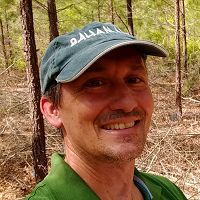Brecheisen et al., 2017
Old-field succession: Land-use legacies and below-ground respiration
Brecheisen, Zachary, Daniel Richter, Will Cook, Paul Heine (2017)
Ecological Society of America Annual Meeting, Portland, OR, 6-11 August 2017
-
Calhoun, GRAD STUDENT
-
Calhoun, INVESTIGATOR
-
Calhoun, STAFF
-
Calhoun, STAFF
Abstract
Background/Question/Methods
In order to investigate the effects of ~80 years of old-field succession in the SC Calhoun Critical Zone Observatory (CCZO) regarding soil biogeochemistry, chronosequence landuse history plots have been instrumented and studied. Chronosequence plots consist of 3 reference hardwood forest plots, 3 plowed agriculture plots, and 3 old-field secondary pine forest plots. In this framework, reference hardwood soil profiles are minimally degraded in terms of erosion, soil structure, and soil biogeochemistry. Each landuse history comparison plot has four 750ml gas reservoirs buried at 0.5m, 1.5m, 3m, and 5m with sampling ports at the surface for in situ CO2 and O2analyses as well as soil gas collection for laboratory analyses. Plowed agricultural plots represent degraded, non-regenerated states, while old-field pine forest plots are expected to be intermediately degraded. This investigation seeks to determine how different landuse histories and above ground ecology among continuously cultivated, old-field secondary forests, and reference hardwood plots are reflected in soil profile metabolic gas concentrations of oxygen and carbon dioxide.
Results/Conclusions
Results indicate that hardwood forest soils generally have higher summer CO2 concentrations than agricultural or old-field pine forests during peak growing seasons but undergo rapid declines in shallow soil CO2 concentrations at 0.5m and 1.5m relative to pine forests during fall and winter. Old-field pine forest soil CO2 is frequently greater than reference hardwood forest soils during winter months. This seasonal response is likely due to an additive interaction between forest metabolism and soil profile structural characteristics. Root respiration and CO2 efflux drops dramatically in deciduous communities compared to pine-dominated evergreen communities in the fall and winter. Additionally, landuse history legacies reflected in soil macroporosity are thought to play a role as intact and extensive macropores in hardwood forests may allow for soil gasses to evade more rapidly into the above-ground atmosphere relative to previously deforested and plowed old-field pine forests. Agricultural soils have much lower CO2 concentrations relative to either forested condition and serve to highlight the degree of regeneration and vertical propagation of respiring old-field pine forest root networks. Oxygen concentrations are reciprocal to CO2 and serve to confirm and reflect the metabolic aerobic consumption of O2 belowground.
Citation
Brecheisen, Zachary, Daniel Richter, Will Cook, Paul Heine (2017): Old-field succession: Land-use legacies and below-ground respiration. Ecological Society of America Annual Meeting, Portland, OR, 6-11 August 2017.
 This Paper/Book acknowledges NSF CZO grant support.
This Paper/Book acknowledges NSF CZO grant support.
Explore Further




